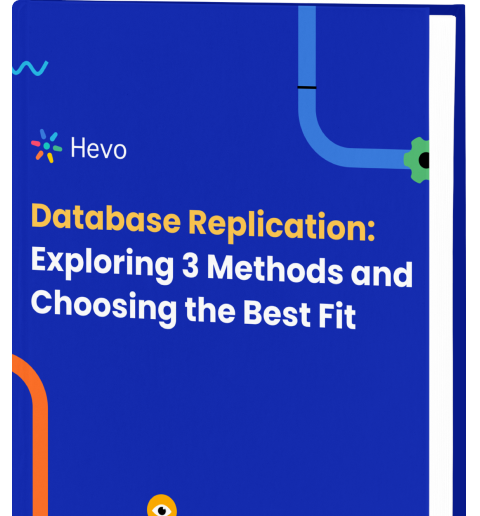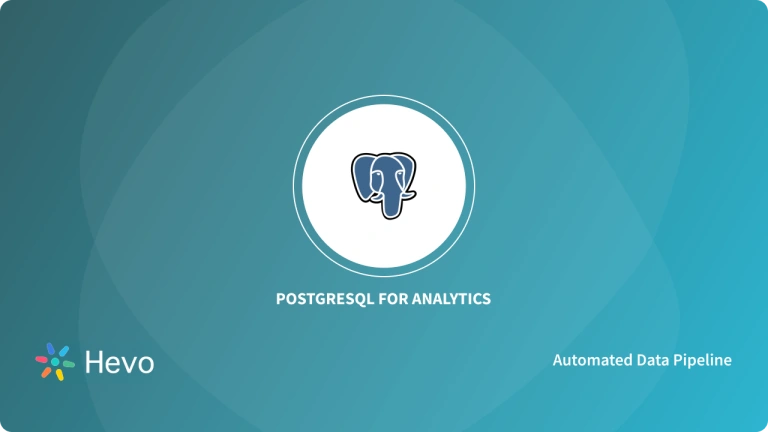PostgreSQL is one of the most robust Relational Database Management Systems. You can use SQL to create tables and store data in your databases.
The data you would want to enter in your table would be of different types, some might be numbers, alphabet, special characters, etc. Hence, there are different data types that would act as guidelines for the different kinds of data to be entered in the fields.
Character types are the data types that are applicable to the fields that can hold character data. The different character types are PostgreSQL Varchar, Char, and Text data types.
In this article, you will come to know about the different character types supported by PostgreSQL. You will also come along with examples of usage of Varchar in PostgreSQL, Char and Text data types.
Table of Contents
What are Character Types?
A data type specifies the guidelines regarding the type of data that can be included in a table column or variable. It is a necessary and crucial phase in the design of a table. Character types are data types that can be allocated to fields that will hold character and string values.
A table with the wrong data types can cause problems such as poor query optimization, performance concerns, and data truncation.
Hevo is the only real-time ELT No-code Data Pipeline platform that cost-effectively automates data pipelines that are flexible to your needs. With integration with various data sources (60+ free sources), we help you not only export data from sources & load data to the destinations but also transform & enrich your data, & make it analysis-ready.
Hevo’s salient features include:
- It is an easy-to-use interface; there is no need for any prior coding knowledge.
- Highly Scalable and fault-tolerant architecture.
- Transparent pricing with various tiers to choose from to meet your varied needs.
- Real-time data integration ensures that your data is always analysis-ready.
Thousands of customers trust Hevo for their ETL process. Join them and experience seamless data migration.
Get Started with Hevo for FreeWhat are the Character Types in PostgreSQL?
The different character types supported by PostgreSQL are as follows:
- Character(n)
- Char(n)
- Character Varying(n)
- Varchar(n)
- Text
Out of the 5 character types, these can primarily be categorized into 3 types based on their similarities.
PostgreSQL Character Types: Overview
For having in-depth information about the three primary character types in PostgreSQL, you can move forward.
1) PostgreSQL Char Data Type
Character data, often known as CHAR in PostgreSQL, represent the character type values. In other words, the PostgreSQL character data type is used when you want the variable to store a character of limited length. This length value can be specified as a parameter of the Char or Character type.
Char datatype is a fixed-length data type i.e., so if there is any remaining space then it is padded with blanks.
The following character data types can be used interchangeably.
- char(n)
- character(n)
A) PostgreSQL Char Data Type – Syntax
variable_name CHAR(n)
Or
variable_name CHARACTER(n)Here, variable_name is the name of the variable which should be of char datatype. And n represents the maximum length of a string which can be used as the variable_name.
B) PostgreSQL Char Data Type – Example
You have to assign the data type to a variable while creating a table. Hence, the datatype is used along with the CREATE statement.
CREATE TABLE Character_type (
Id serial PRIMARY KEY,
X CHAR (1),
Y CHAR (10)
); Here, you are creating a Character_type table, in which the variables are Id, X, and Y. Here, X and Y are of character types. And the length of any string assigned to X and Y can be a maximum of 1 character and 10 characters.
Now, while inserting values into the table:
INSERT INTO Character_type (X,Y)
VALUES
('DPS', 'They provide the best education'), After executing the above command, you will get the following output mentioning, “the value is too long for type character varying (1)“. Since for both the variables, the character lengths exceed the 1 and 10 length limit.
To resolve the error you can enter the following command:
INSERT INTO Character_type (X,Y)
VALUES
('A', 'Josephines'), After executing the above INSERT statement, 1 row will be inserted into the table with the values entered. And both X and Y have values within the maximum limit of the parameters mentioned.
2) PostgreSQL Varchar Data Type
The PostgreSQL Varchar data type is used to store characters of indefinite length based on the parameter n. It can store a string up to 65,535 bytes long.
- In the PostgreSQL Varchar data type i. e. Varchar(n), n is used to denote the character length limit. If n is not specified, PostgreSQL varchar default length defaults to a character of infinite length.
- PostgreSQL checks and throws an error if you try to get a longer string in a column specified by PostgreSQL Varchar(n).
- If the extra characters are assigned to a variable that is all whitespace in the PostgreSQL varchar data type, the whitespace is truncated to the maximum length (n) and the string is stored. This is the reason why the PostgreSQL Varchar data type is called the variable-length data type.
The PostgreSQL Varchar data types are:
- Varchar(n)
- Character Varying(n)
A) PostgreSQL Varchar Data Type – Syntax
variable_name VARCHAR(n)
Or
variable_name VARYINGING(n)Here, variable_name is the name of the variable which should be of char datatype. And n is the parameter of the PostgreSQL Varachar datatype which represents the length of a string that can be used as the variable_name.
B) PostgreSQL Varchar Data Type – Example
You have to assign the data type i.e, PostgreSQL Varchar to a variable while creating a table. Hence, the datatype is used along with the CREATE statement.
CREATE TABLE Varchar_type (
Id serial PRIMARY KEY,
P VARCHAR(3),
Q VARCHAR(13)
); Here, you are creating a Varchar_type table, in which the variables are Id, X, and Y. Here, X and Y are of character types. And the length of any string assigned to X and Y can be a maximum of 3 and 10 characters.
Now, while inserting values into the table:
INSERT INTO Text_type (X,Y)
VALUES
('DEMS', 'They provide the best education'), After executing the above command, you will get the following output mentioning, “the value is too long for type character varying (1)“. Since for both the variables, the character lengths exceed the 3 and 13 length limit.
To resolve the error you can enter the following command:
INSERT INTO Varchar_type (X,Y)
VALUES
('DPS', 'Best Education'), After executing the above INSERT statement, 1 row will be inserted into the table with the values entered. And Since for the Y variable, you have sent the varchar type with a maximum length of 13, so in ‘Best Education‘, it will automatically adjust, remove the space and save it.
Key Features of PostgreSQL Varchar Data Type
- Variable Length: The Varchar data type stores strings with a variable length, meaning it only uses the amount of space needed for the text, up to a specified limit.
- Flexible Character Storage: Varchar can store any kind of text, including letters, numbers, and special characters, offering flexibility in the types of data it can hold.
- Length Restriction: While Varchar can store variable-length data, you can set a maximum length limit (e.g., Varchar(255)) to restrict the number of characters. This helps in maintaining consistency in data size.
- Efficiency: Storing text in a Varchar field is more efficient compared to fixed-length types like Char because it only uses the space necessary for the stored value.
- Compatibility: PostgreSQL Varchar is compatible with many other databases, making it easy to migrate or integrate with other systems.
- Supports Unicode: The Varchar data type in PostgreSQL supports Unicode, meaning it can store text in multiple languages and special characters from different writing systems.
- No Padding: Unlike the Char data type, Varchar does not add padding spaces to the data, which helps save storage space for shorter strings.
3) PostgreSQL Text Data Type
The PostgreSQL Text data type is used to keep the character of infinite length. PostgreSQL text max length is 65,535 bytes.
Postgres text max length is the same as the PostgreSQL Varchar data type, rather without any argument for mentioning the length of the character ie., the PostgreSQL Varchar Data Type without n is the same as the Postgres text size.
A) Syntax
variable_name TEXT Here, variable_name is the name of the variable which should be of TEXT datatype.
B) Example
You have to assign the data type to a variable while creating a table. Hence, the datatype is used along with the CREATE statement.
CREATE TABLE Text_type (
Id serial PRIMARY KEY,
X TEXT,
Y TEXT
); Here, you are creating a Text_type table, in which the variables are Id, X, and Y. Here, X and Y are of TEXT types. And the length of any string assigned to X and Y can be anything.
Now, while inserting values into the table:
INSERT INTO Text_type (X,Y)
VALUES
('DPS', 'They provide the best education'),
('DEMS', 'They have great scope for extra-curricular activities'); After executing the above INSERT statement, 2 rows will be inserted into the table with the values entered.
Use Cases of PostgreSQL Varchar Data Type
The PostgreSQL Varchar data type is commonly used in various scenarios where text data needs to be stored efficiently. Here are some common use cases:
- Storing Usernames and Emails
Varchar is ideal for storing short text fields like usernames or email addresses, as it allows for variable-length storage, optimizing space. - Address Fields
For systems that require address details, such as street names, cities, and postal codes, Varchar provides flexibility while maintaining performance. - Product Codes and Serial Numbers
Many applications store product codes or serial numbers in Varchar format. This is especially helpful when codes may vary in length, or include letters, numbers, or symbols. - Descriptions or Comments
Varchar is often used for storing descriptions, notes, or user comments. It supports flexible text entries without wasting space on fixed-length fields. - Searchable Data Fields
If you need to store data that will be used in search queries, such as titles or tags, Varchar is an excellent choice. It allows easy indexing for fast retrieval without the need for a fixed length.
Conclusion
This article illustrated the concept of different character types supported by PostgreSQL. You had an in-depth understanding of the PostgreSQL Varchar, Char, and Text datatypes.
Now, you can move forward and assign the different character types while creating tables.
Want to explore more about different clauses and statements while writing queries and creating tables in PostgreSQL? You can go through these articles.
- Working with PostgreSQL Subquery | A 101 Guide
- PostgreSQL SELECT Statement: Syntax & Example Queries | A 101 Guide
It will take a lot of time to import and move data into your selected warehouse by using ETL for Data Analysis with PostgreSQL as your data source. When you consider how much money and resources are required to engage data engineers and analysts to make sense of this data, the issue becomes even more daunting.
However, with Hevo at your fingertips, you won’t have to worry about your PostgreSQL Data Replication demands. Loading your data into your chosen data warehouse will just take a few minutes.
Hevo’s strong integration with 150+ data sources (including 60+ free sources), such as PostgreSQL, allows you to export data from your selected data sources and load it to the destination of your choice. It also assists you with reorganizing and enhancing your data so that it is ready for analysis. Sign up for Hevo’s 14-day free trial and experience seamless data migration.
FAQ on PostgreSQL VARCHAR
1. What is the VARCHAR in PostgreSQL?
VARCHAR in PostgreSQL is a variable-length character data type that allows you to store strings with a defined maximum length.
2. Should I use VARCHAR or TEXT in PostgreSQL?
Use TEXT for unlimited-length strings and VARCHAR if you want to enforce a length constraint. Both are functionally similar, but TEXT is often preferred for flexibility since there’s no performance difference.
3. How to declare VARCHAR in PostgreSQL?
In PostgreSQL, you can declare a VARCHAR data type using the syntax:column_name VARCHAR(length);













